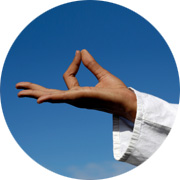
The word “yoga” is derived from the Sanskrit root, yuj which means “to join” or “to yoke”. Sanskrit is the ancient language from India which was created as a spiritual language (it was not commonly used in the streets but in the temples by brahmin priests or by vedic scholars).
The related meaning of yoga is “to focus attention on” or “to use”. Hatha Yoga is an ancient art based on a subtle science, that of the body, mind and soul. Yoga helps one to join up the body, mind and soul, in “union”. The word union is one of the most common ways of translating the word yoga. It’s this union that yoga aims for, both within ourselves and also with the world around us. When we are having a bad time, be it emotionally or physically, we will feel separate from our bodies, mind or soul, or we feel disconnected from everything around us in the world. Yoga aims to remove this sense of separation. Yoga helps us to find union with our body, mind and soul. And when we are reunited with ourselves, then we will feel reunited with the world and people around us. When we feel in union with ourselves and the world around us, we feel so much better. Everything looks so much better and we have the strength to move on. Yoga can help on any level: from feeling bad due a sore body to feeling emotionally drained and sad. Yoga has the tools to mend all of these things.
 The word “hatha” has various meanings, including “will power”. For our purposes, this will power refers to the discipline needed to consistently practice (and this includes the discipline of coming to my classes regularly). Through the will power to keep practising (as often as you can manage) you will deepen an understanding of yoga. Yoga is not a quick fix. Like many things in life, depth comes through practice.
The word “hatha” has various meanings, including “will power”. For our purposes, this will power refers to the discipline needed to consistently practice (and this includes the discipline of coming to my classes regularly). Through the will power to keep practising (as often as you can manage) you will deepen an understanding of yoga. Yoga is not a quick fix. Like many things in life, depth comes through practice.
Another way of explaining hatha is to split the word up into its Sanskrit roots. “Ha” represents the ida nadi (the left channel – or left nostril when breathing in pranayama) and the cool energy of the moon (chandra), which is also represented as the female side. “Tha” represents the pingala nadi (right channel – or right nostril when breathing in pranayama) and the hot energy of the sun (surya), which is also represented as the male side. When practising hatha yoga one wants to attain a balance between these two sides, or forces in us, so that they are in harmony. In general terms, when practising yoga you will become more sensitive to your body and as a result become more aware of differences between your right and left sides. One might be stronger and/or more flexible. Through yoga you can help close the gap between the sides. And through time, this metaphorical gap will close in many areas of your life, and you will feel more balanced not just within your body and mind, but also with the people and world around you. In hatha yoga the breath is the key. “Hathayoga Pradipika” is a practical treatise on yoga, and in it the author stresses importance of breath by saying that if the mind is the king of the senses, the master of the mind is the breath.
For more information about yoga – yoga philosophy, practice advice and tips, please read Inside Yoga – Gary’s Yoga Blog.
Recommended articles on my blog page:
Meditation explained – Find meditation hard? Read this and be reassured, https://www.yogabristol.co.uk/2019/12/02/meditation-explained/
Stick to the point – training our mind, read https://www.yogabristol.co.uk/2019/10/21/sticking-to-the-point/
Practice, patience and perseverance, keep calm and carry on – https://www.yogabristol.co.uk/2019/05/06/practice-patience-perseverance/
How many yogas are there? – https://www.yogabristol.co.uk/2016/09/19/how-many-yogas-are-there/
How many yogas are there? Part 2 – https://www.yogabristol.co.uk/2016/09/26/how-many-yogas-are-there-part-2/
Yoga is meditation – https://www.yogabristol.co.uk/2017/03/13/yoga-is-meditation/
How many yoga postures are there?- https://www.yogabristol.co.uk/2017/01/16/how-many-yoga-postures-are-there/
